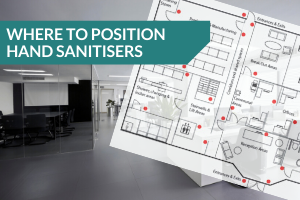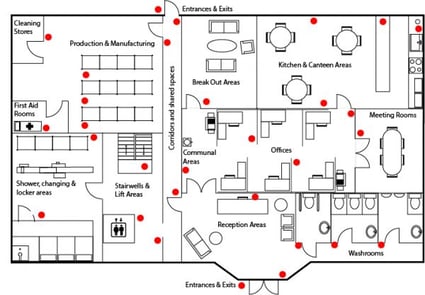Where to Place Hand Sanitisers in the Workplace

June 30, 2020
As the coronavirus lockdown restrictions begin to ease and more people return to work, the importance of good hand hygiene has perhaps never been more widely appreciated. Britain has been especially hard-hit by Covid-19 and, with everyone keen to avoid a deadly ‘second wave’ of infections, there’s enormous pressure on both employers and workers to maintain the safest possible working environments.
Physical distancing, the use of face coverings and alertness to the symptoms of the virus all have important parts to play, but one of the simplest public health messages remains one of the most important: proper hand washing is the most effective and easiest way to protect against infection. This guidance is endorsed by the UK Government and the World Health Organisation.
How Hand Cleansers and Sanitisers Work
Soap can take the form of a liquid, gel or foam, and when hand washing with soap, two key actions are at work. Firstly, the physical action of washing helps to shed any contamination from the hands. This is why such emphasis is placed on washing the whole of each hand – front, back, wrists, between the fingers and thumbs etc. – and for washing for a sufficient length of time. Water alone can help to shed the virus from the skin but soap helps to break the bonds between the two, and makes the process considerably more effective.
The second action takes place at the molecular level. Soap molecules are able not only to surround the coronavirus (and many other pathogens besides) but also to pierce and dissolve the virus’ fatty outer layer. In effect, soap is able to burst the virus, rendering it inactive, and then (importantly) it also helps to remove it from the skin.
The combination of soap and water is widely regarded as the best, most effective solution for protecting against infection but, practically speaking, it isn’t always possible to situate a basin and water supply everywhere that hand hygiene facilities are needed. In such circumstances, alcohol-based gels are a useful asset because hand sanitiser dispensers can be easily distributed and positioned far more widely within a working environment. We’ll consider why this is so important later on.
Like soap, alcohol-based hand sanitisers work by attacking the outer fatty (lipid) layer of the virus. However, to be effective, the alcohol content must be above 60%. The alcohol also needs to come into direct contact with the virus, which it cannot always do if, for example, the virus stays protected beneath a layer of oil, grease or dirt on the hands. Nevertheless, it is a valuable resource when soap and water aren’t immediately available and, if scrupulously applied to the whole of both hands and wrists, it can offer an important line of defence.
Benefits of Hand Sanitiser
Both soap and alcohol-based hand sanitisers have roles to play in workplace hygiene. They will help to keep staff safe, will help to reduce the risks of transmission to others and they will play their part in helping to minimise the costs and disruption associated with sickness and self-isolation.
How Can Hand Sanitiser Help?
By now, most people in the developed world will be aware of the importance of good hand hygiene and most of them will probably have become more fastidious at home, particularly with regard to the use of hand sanitisers. Those who have continued to attend their workplace, or those who are just now returning to their workplaces should, one hopes, be bringing these familiar hygiene routines with them.
In the home, certain points and areas are commonly touched by the occupants: door handles, taps, TV remote controls and so on. Exactly the same is true of working environments, whether they are offices, factories, retail stores or any number of other premises. A key challenge is to recognise these higher-risk areas and to be aware of items that may easily be passed around from one to another. Any object – from a coffee mug to a telephone; from the photocopier to an item of stock – can be a potential vector for harmful bacteria, which is able to survive on a variety of surfaces, sometimes for several days.
In short, any point of physical contact can be a potential risk and, since it’s estimated that the average worker touches his/her face every two to five minutes, it’s easy to see why regular, frequent hand cleansing is so essential. But, of course, cleansing is only possible where the necessary facilities exist, so this brings us to another vital consideration: deciding where to position hand sanitiser dispensers.
Having a sufficient number of dispensers visible and well-positioned in a workplace not only facilitates good hygiene practices, it also acts as a constant reminder. A building’s occupants are far more likely to maintain these practices when they are receiving constant visual prompts, and when using a dispenser is made easy, quick and convenient.
Best Hand Sanitiser Placement for Good Workplace Hygiene
There are locations in any building that present heightened risk of contact, infection and cross-contamination. They vary according to the type of building, the size of the workforce and the kinds of work that are being performed. Consequently, employers should ideally undertake a thorough survey of their premises and identify any heavily trafficked contact points that would benefit from having a hand sanitiser dispenser set close by.
There is no substitute for applying careful thought on-site. However, as a rule of thumb, there tend to be certain locations that commonly present a higher risk. To help building managers to identify these and to plan accordingly, we have produced a free, downloadable guide: “Hand Hygiene in The Workplace - A Best Practice Guide.”
The Guide features the following illustration, which shows a typical working environment and identifies potential infection hotspots where it may be helpful to provide hand sanitiser.

Corridors & Communal Spaces
Popular, well-used areas such as reception areas, corridors and other communal spaces are logically one of the most high-risk zones, simply because more people increases the potential for cross contamination. Providing clearly visible dispensers in these areas not only enables effective hygiene, it also acts as a constant reminder of company policy and individual obligations. For this reason, it is especially important to situate hand sanitisers in reception areas. Doing so encourages good hand hygiene immediately, before any distractions take hold, so it acts as an effective ‘safety induction’ to the premises.
Here, as with all the following locations, it is important that any dispensers are clearly visible, supported by signage where feasible, and that they are accessible without obstruction. Using hand sanitisers should be made as easy and convenient as possible.
Stairwells & Lift Areas
It’s natural that when someone uses the stairs, he or she will use the handrail. From a general safety perspective, it’s important that they do, but the presence of such a commonly touched surface does inevitably increase the risk of infection. Consequently, it is good practice to situate hand sanitiser dispensers at the top and bottom of every stairwell, and on any landings in between.
Much the same is true of lifts, stairlifts and escalators. Lifts require the user to touch a number of buttons, escalators have handrails, and stairlifts may have safety bars or belts as well as the controls themselves. In all cases, hand sanitiser should be provided at every floor so that regardless of the journey, users can always keep themselves protected.
Production & Manufacturing Areas
Businesses with on-site plant and machinery should take particular care to understand how these items are used and where any contamination risks can arise. Where there are simple, short rows of work benches (or similar), it may be sufficient to place dispensers at the end of each row. However, manufacturing areas vary considerably in design and usage, so any decision on the placement of dispensers needs to be the result of careful scrutiny. That said, entrances and exits are obvious hot-spots, as are any handrails, gantries, machine consoles or other controls that may be touched by multiple employees. Consider how operatives act and move through these areas, and where dispensers may be safely situated – taking into account visibility, convenience and avoidable risks such as trip hazards.
Shower, Changing & Locker Areas
In premises that feature changing areas or shower facilities, employees will typically be touching doors, lockers, basins and shower controls, together with other surfaces. At minimum, hand sanitiser should be made available immediately outside any entrances and exits, and by doors to any partitioned areas.
Washrooms
Washrooms present similar challenges to shower rooms and changing rooms. Again, as a minimum, dispensers should be placed outside the washroom doors so that they can be used before and after visiting the room and coming into contact with door handles. Washrooms will already have basins, dispensers and hand drying facilities inside so no duplication of washroom equipment is likely to be necessary; only sensible monitoring to ensure that supplies of soap and any paper towels are reliably maintained.
Kitchen & Canteen Areas
Key contact areas in kitchens and canteens include worktops, serving counters, trays, tables, chairs and doors. Kitchen staff should be equipped with their own supply of hand sanitiser and a separate dispenser is useful on any serving counter, where trays and other items may be passed from hand to hand. It may be impractical to install dispensers at or by every table but, as a minimum precaution, they should be installed in visible, easily accessible parts of the room such as against empty walls and by entrances.
Offices
Office layouts vary. For rooms with individual cubicles, dispensers should be placed at regular intervals in any through-ways and they should be made accessible to passing colleagues without creating a risk of infringing safe distances between staff. For more open plan environments, dispensers should be placed at the end of each row of workstations, presuming of course that the office design also allows for safe distancing. As with other commonly used areas, dispensers should also be situated by any exits.
Meeting Rooms
In smaller meeting rooms, a single dispenser just inside the entrance door(s) may be adequate. In larger rooms such as those used for seminars and larger presentations, dispensers should be installed by all doors and, if necessary, at the ends of any aisles between seating. As noted elsewhere, this assumes that other safety measures, such as proper distancing, are also being observed.
Get in Contact with Dudley Industries
These topics are covered in greater detail in Dudley Industries’ free PDF download: “Hand Hygiene in The Workplace - A Best Practice Guide.” It also offers advice on effective hand-washing techniques and features links to NHS websites that provide further information and advice.
Please note that different dispensers are more suitable than others for particular purposes. Options include:
- Free-standing or wall-mounted
- Integrated hand sanitiser dispenser and stand
- Children's hand sanitiser stand
- Soap or sanitiser
- Small or large capacity
- Material (e.g. stainless steel or plastic)
Before making any purchase, it’s helpful take the time to research the different options. Explore Dudley Industries range of commercial soap and sanitiser dispensers or, if you would like help in choosing the right dispensers or in planning how they ought to be situated, please get in touch with one of our customer advisors today. Call (0)1253 738311 or email sales@dudleyindustries.com